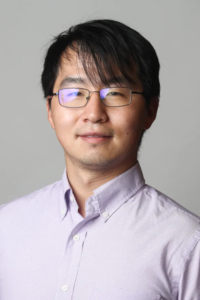 Dr. Zhenyu Tian (he/him) is an environmental chemist curious about organic pollutants in the environment. He received his Ph.D. from the University of North Carolina, where he studied the transformation products and co-occurring pollutants of PAHs in contaminated soil. Then he worked as a postdoctoral research scientist at the Center for Urban Waters, University of Washington Tacoma, applying non-target screening to identify emerging contaminants in water and biota and to evaluate engineered treatment systems. With the research group, he identified 6PPD-quinone, a ubiquitous tire rubber chemical that kills coho salmon via urban stormwater. Dr. Tian is an Assistant Professor in the Department of Chemistry and Chemical Biology. He is also affiliated with the Department of Marine and Environmental Sciences and the Barnett Institute for Chemical and Biological Analysis.
Dr. Zhenyu Tian (he/him) is an environmental chemist curious about organic pollutants in the environment. He received his Ph.D. from the University of North Carolina, where he studied the transformation products and co-occurring pollutants of PAHs in contaminated soil. Then he worked as a postdoctoral research scientist at the Center for Urban Waters, University of Washington Tacoma, applying non-target screening to identify emerging contaminants in water and biota and to evaluate engineered treatment systems. With the research group, he identified 6PPD-quinone, a ubiquitous tire rubber chemical that kills coho salmon via urban stormwater. Dr. Tian is an Assistant Professor in the Department of Chemistry and Chemical Biology. He is also affiliated with the Department of Marine and Environmental Sciences and the Barnett Institute for Chemical and Biological Analysis.
Read Zhenyu’s Emerging Investigator Series article “In-depth chemical profiling of tire and artificial turf crumb rubber: aging, transformation products and transport pathways” and read more about him in the interview below:
Your recent Emerging Investigator Series paper focuses on chemical profiling of crumb rubber in tire and artificial turf at different ages. This is not the first time you’ve published in ESPI! You’ve previous coauthored papers on the complexity of contaminants mobilized from storms, characteristics of the ubiquitous transformation that you discovered – 6PPD-quinone, and you even co-edited a special issue on complex chemical mixtures . How has your research evolved from your first article to this most recent article?
I would say those earlier publications reflected a slight shift and expanding of research topics. The San Francisco Bay stormwater paper summarized a multi-year, multi-group project that dates back to 2018 and the samples provide support for stormwater as a source of high concentrations of tire-rubber related chemicals. With the discovery of 6PPD-quinone as the toxicant related to coho salmon mortality, we then did experiments to figure out its properties, like solubility, octanol-water partition coefficient, and sorption to common container materials. Now, at Northeastern University, the focus of my group is chemical contaminants from end-of-life tires, which is the subject of this new paper. Here, we discuss the aging and transformation of crumb rubber in artificial turf fields.
What aspect of your work are you most excited about at Northeastern University at the moment?
Working with students is probably one of the most exciting things. Both graduate students and undergrads at this university are outstanding. Also, the atmosphere really encourages interdisciplinary collaboration, which is great.
In your opinion, what are the most important questions to be asked/answered in this field of research?
In the realm of environmental chemistry, there are numerous unanswered questions on organic pollutants. While my perspective represents only a small part of the larger picture, I am particularly intrigued by the question: “What contaminants have the most significant impact under real environmental conditions?”. The focus on identifying the most impactful contaminants is crucial because we face an overwhelming number of organic pollutants, which is impractical to test, remediate and ban. Simultaneously, we recognize that many human diseases and ecological issues are likely linked to these contaminants. The challenge lies in bridging the gap between these two realities – identifying which specific pollutants are responsible for these problems.
What do you find most challenging about your research?
Oof, a lot of challenges! For now, I am mostly troubled by 1) getting more grants to support my projects, both ongoing or in mind and 2) finding collaborators in toxicology. Consider this an open call: Dear toxicologists in the Greater Boston Area and the northeastern United States, let’s discuss and collaborate!
In which upcoming conferences or events may our readers meet you?
Dr. Imma Ferrer from the University of Colorado Boulder and I will be hosting an invited symposium on Innovations and Future Directions in Environmental Non-Targeted Analysis at PittCon 2025, which is a conference on analytical chemistry, in Boston from March 1-5. We have lined up four great speakers. See you there!
How do you spend your spare time?
I spend time with my family and my dog. I used to have some time for sports and games, but less so now.
Which profession would you choose if you were not a scientist?
I want to work on many things but I doubt a profession is realistically achievable these days. Maybe a hunter? Archaeologist? Paleontologist?
Can you share one piece of career-related advice or wisdom with other early career scientists?
Wow, this is a hard one as I am still struggling as an early career scientist. As such, this is not advice and maybe not even wisdom, but more of an opinion: I see myself/my career as an experiment. We make hypotheses and we put in effort that we think are correct and then see if it all works. If not, we acknowledge it’s a negative result. If someday I am not working as a scientist, that means my experiment didn’t end up working.










